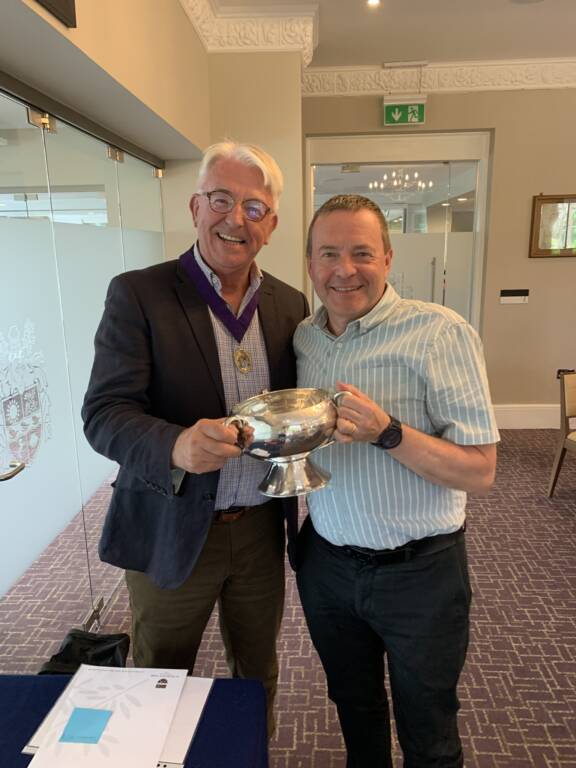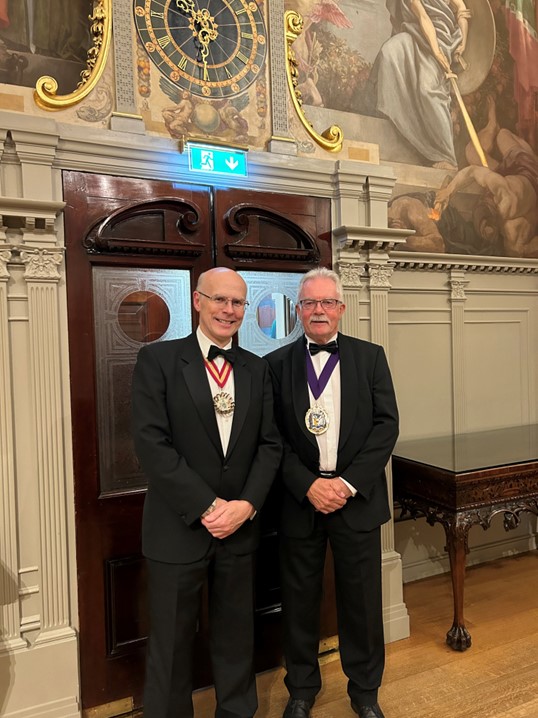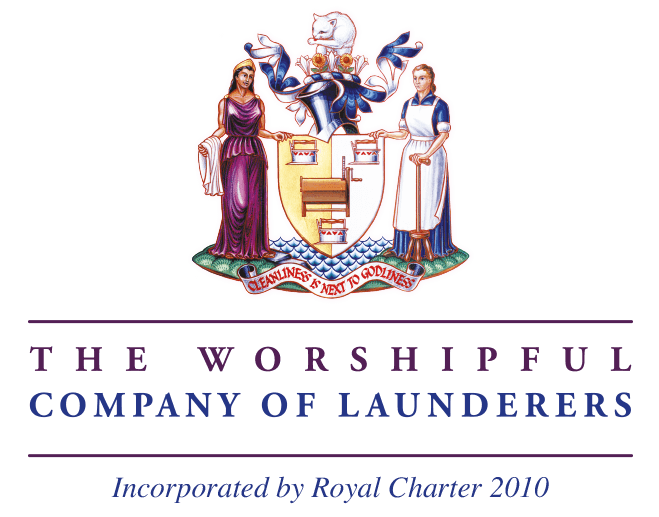November started on Monday the 1st with an evening visit to the Guildhall for the John Keats Anniversary Lecture. Keats was an English poet prominent in the second generation of Romantic poets, along with Lord Byron and Percy Shelley, although his poems had been published for only four years when he died of tuberculosis at the age of 25 they were at first indifferently received, but his fame grew rapidly after his death.
The event was in fact the 200th anniversary of his death and he was born in October 1795 the son of a livery-stable manager, John Keats received relatively little formal education. His father died in 1804, and it now appears that Keats father was more than just a livery stable manager but was also a London volunteer yeoman. A yeoman was a person of respectable standing, one social rank below a gentleman, and the yeomanry was required to provide their own horses and were recruited mainly from the middle class who featured prominently in the rank and file whilst Officers were largely recruited from among the nobility and landed gentry. A commission generally involved significant personal expense, and although social status was an important qualification, the primary factor was personal wealth. From the beginning, the newly rich, who found in the yeomanry a means of enhancing their social standing, were welcomed into the officer corps for their ability to support the force financially. Urban recruitment increased towards the end of the 19th century, reflected in the increasingly common use of hired mounts which is where Keats father came in. The yeomanry was first used in support of local authorities to suppress civil unrest. It appears that Keats mother remarried almost immediately after his father’s death.
Throughout his life Keats had close emotional ties to his sister, Fanny, and his two brothers, George, and Tom. After the breakup of their mother’s second marriage, the Keats children lived with their widowed grandmother at Edmonton, Middlesex. John attended a school at Enfield, two miles away, that was run by John Clarke, whose son Charles Cowden Clarke did much to encourage Keats’s literary aspirations.
At school Keats was noted as a pugnacious lad and was decidedly “not literary,” but in 1809 he began to read voraciously. After the death of the Keats children’s mother in 1810, their grandmother put the children’s affairs into the hands of a guardian, Richard Abbey. At Abbey’s instigation John Keats was apprenticed to a surgeon at Edmonton in 1811. He broke off his apprenticeship in 1814 and went to live in London, where he worked as a dresser, or junior house surgeon, at Guy’s and St. Thomas’ hospitals. His literary interests had crystallised by this time, and after 1817 he devoted himself entirely to poetry. From then until his early death, the story of his life is largely the story of the poetry he wrote.
“On First Looking into Chapman’s Homer” is a sonnet written by Keats in October 1816. It tells of the author’s astonishment while reading the works of the ancient Greek poet Homer as freely translated by the Elizabethan playwright George Chapman and it was first published in “The Examiner” in 1816 and later published in Poems (1817), Keats’s first collection. Considered the poet’s first mature poem, the sonnet was inspired by Keats’s having pored over a 1616 folio edition of George Chapman’s English translations of the “Iliad and the Odyssey”, and it is Keats’s response to heroism.
Just a few days later we had the LADAs, the laundry and dry cleaning industry competition, organised by the Laundry and Cleaning Today magazine, but mentioned here because all members of the panel of judges are in fact Members of our Livery and a winner of one event was himself a former Master, Colin Hill.
Monday 8th of November representatives of all of the City of London livery companies mustered at Plaisterers’ Hall in preparation for a short walk to St Paul’s Cathedral for the City and Livery Garden of remembrance service. Following the service all of the livery Masters attending each placed a cross, with a poppy, into the ground in remembrance of the fallen during all of the nation’s wars. The following day was the Entrepreneurs’ Raleigh Lecture Tuesday 9th November at Drapers’ Hall which was entitled “Globalisation: Opportunities and Threats”. Whilst on Thursday we had the Scientific Instrument Makers Zoom Lecture on the Whittle Jet. This was an interesting presentation on an invention, first conceived in the 1930s, that later changed air travel out of all recognition and if developed earlier could have shortened the second world war considerably.
Saturday 13th Renter Warden, Simon Fordham, and I represented the Launderers at the Lord Mayors Show when we joined the Modern Liveries Float along with other Livery Company senior representatives. If you want to see us in the Lord Mayor’s Show follow this link https://youtu.be/PTG561NUHIs and we are about 4.49 minutes in from the beginning. The pace of the parade was much quicker than I remember from previous years and the other feature was the protesters who glued themselves to the road trying to stop the parade. The following Sunday was the Remembrance Day service held in St Paul’s Cathedral followed by a walk down to the Royal Exchange for a wreath laying ceremony and then a march past by the Military plus bands whilst we viewed from the front of the Mansion House.
Later in November there was an invitation from the Lord Mayor to his Chapel, St Stephen Walbrook which is a church in the City of London behind the Mansion House for a reception and talk from him on his plans for the year. The church’s domed building was erected to the designs of Sir Christopher Wren, following the destruction of its medieval predecessor in the Great Fire of London in 1666. This church is also the original founding home of The Samaritans, the listening service which has saved so many lives and the Samaritans began here in 1953 at St Stephen Walbrook, founded by the then rector Reverend Chad Varah. In the centre of the church is the Henry Moore altar, a huge, sculpted stone block made from travertine marble and cut from the quarry used for many of Michelangelo’s works and this was placed in the church in 1987.
Later that evening we had our Livery social gathering at the HAC (Honourable Artillery Company) with the Pikemen and Musketeers, and you may remember we had them join us in October providing the guard of honour when we held the Banquet for our Deputy Master, Major Jack Strachan. Our host for the evening was Captain of the Company of Pikemen and Musketeers, Richard Peters and we had also a demonstration of the armoury plus light refreshments. The Honourable Artillery Company was established by Royal Charter in 1537and since the 17th century the Company has also been described as a Regiment. In 1964 it was registered as a charity and its charitable purpose, in line with its original charter, is “for military exercise and training and for the better defence of the realm”. The HAC has occupied Artillery Garden since 1641 and Armoury House, its Headquarters and Mess, was built in 1734. The HAC comprises two indivisible parts: the Regiment (part of the Army Reserve), and a membership of 2,500 active and veteran personnel. It also runs two CCF contingents, a Special Constabulary Detachment, and ceremonial sub-units.
It was a splendid visit and it was nice to joined by visitors from SIM and Glaziers.
Thursday 25th November was a more solemn occasion when we went along to the Celebration of Life Service for Senior Past Master Neville Wells at St. Peter’s Church, Limpsfield, in Surrey. An Obituary has been published and issued separately for this well-respected founder member and former Master.
Later that evening I was honoured to be invited, along with our Clerk, Margaret, to be a guest of the Glaziers’ at their Installation Dinner held at Glaziers’ Hall with over 150 attending. It was a magnificent event with a novel variation of the Loving Cup, especially created for these uncertain times. The cup went around for the ceremony but was it filled with wrapped chocolates and instead of drinking we each took out a chocolate instead of participating in the alcoholic drink.
Many of us have had glimpses of normality over recent months, but 2021 has been another challenging year for us all and as we build up to Christmas please keep your loved ones safe through the festive season and beyond.
May I wish you all a very Merry Christmas and A Happy New Year!





